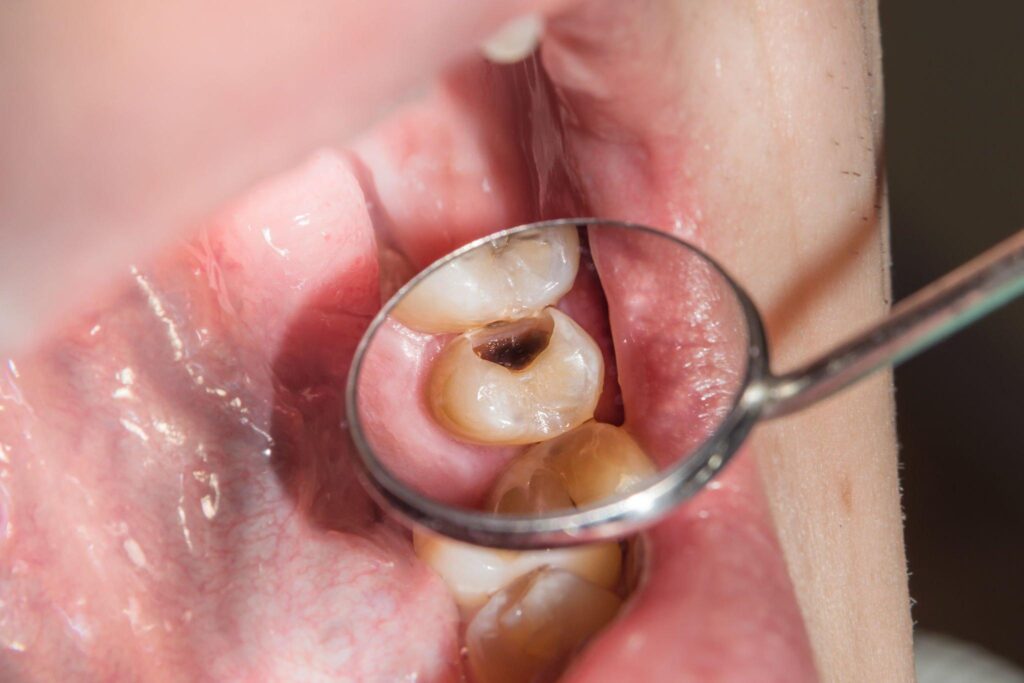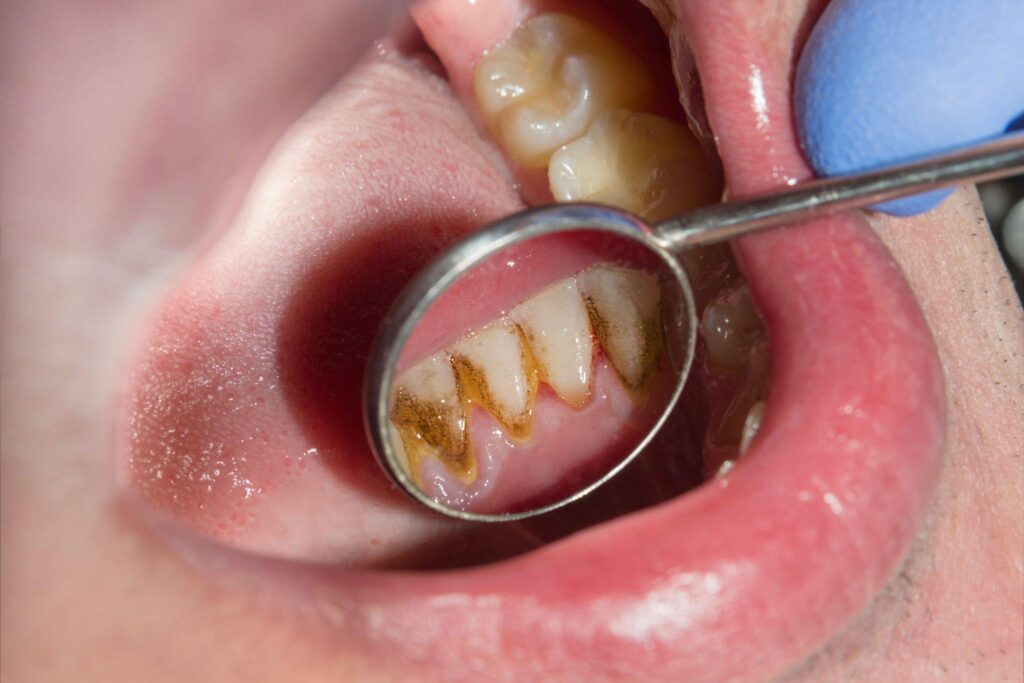Teeth rotting from the gums can be a distressing and uncomfortable experience. However, several treatment options are available to address this issue and restore oral health.
In the early stages of tooth decay, professional dental cleanings and fluoride treatment can effectively treat the problem. These procedures help remove plaque and tartar buildup and enhance the tooth’s natural defenses by strengthening the enamel.
If the decay progresses and reaches the inner layers of the tooth, a dental filling may be necessary. This involves removing the decayed portion of the tooth and filling it with a material like composite resin or amalgam. Dental fillings restore the tooth’s structure and prevent further decay.
In more advanced cases of tooth decay, a root canal treatment may be required. This procedure involves removing the infected tooth pulp and sealing the tooth to prevent reinfection. A crown is often placed over the treated tooth to provide additional protection and restore its functionality.
For patients with gum disease, various treatment options can address the issue. Scaling and root planing are common nonsurgical methods used to remove plaque and tartar buildup from below the gumline. In more severe cases, surgical treatments like gum tissue grafting may be necessary to repair and restore damaged gum tissue.
Seeking professional dental care is crucial for effective treatment of teeth rotting from the gums. Dentists can properly diagnose the extent of the decay or gum disease and recommend the most suitable treatment option. Regular dental check-ups, cleanings, and proper oral hygiene practices are essential in preventing and managing these conditions, ensuring long-term oral health.
The Stages of Teeth Rotting From the Gums

Tooth decay is a common dental problem that can lead to rotting and breaking teeth if left untreated. Understanding the stages of tooth decay is crucial in addressing the issue before it worsens. In the early stages, plaque and tartar buildup can be effectively removed through professional dental cleanings and fluoride treatment to strengthen the tooth enamel.
However, if the decay progresses, a dental filling may be necessary to restore the tooth’s structure and prevent further damage. In more advanced cases, a root canal treatment may be required to remove the infected tooth pulp and seal the tooth.
Gum disease can also contribute to tooth-rotting, and various treatment options are available, such as scaling and root planing or surgical treatments like gum tissue grafting. By recognizing the stages of tooth decay and seeking appropriate dental care, individuals can prevent the unpleasant consequences of rotting and breaking teeth.
Stage 1 – The First Stage Involves Tooth Plaque and Demineralization

Stage 1 of tooth decay begins with the formation of tooth plaque, a sticky film that develops on the surface of teeth. Dental plaque is composed of bacteria, food particles, and saliva. When we consume sugary or starchy foods, the bacteria in plaque feed on the carbohydrates, producing acids that attack the tooth enamel.
Over time, the acids in plaque can cause demineralization, which weakens the outer layer of the tooth. This process initially appears as white spots on the teeth, indicating early signs of tooth decay. These white spots are caused by a loss of minerals from the enamel.
Regular dental check-ups are essential to detect these early signs of demineralization. Dentists can identify the presence of tooth plaque and monitor any changes in the teeth, offering timely prevention and treatment options to prevent further damage.
To maintain good oral health and prevent stage 1 tooth decay, it is crucial to maintain proper oral hygiene practices such as brushing twice a day, flossing daily, and limiting the consumption of sugary and starchy foods. Regular dental cleanings also help remove plaque buildup, reducing the risk of demineralization.
By addressing dental plaque and detecting early signs of demineralization, individuals can prevent the progression of tooth decay and maintain a healthy smile.
Stage 2: Enamel Decay
Stage 2 of tooth decay, known as enamel decay, occurs when demineralization progresses and leads to the formation of small cavities in the enamel. Enamel decay typically starts at the gumline, where plaque and bacteria accumulate and produce acids that attack the tooth’s outer layer.
Demineralization is the process by which the minerals in the enamel, such as calcium and phosphate, are lost due to acid exposure. This weakens the enamel, making it more susceptible to decay. When demineralization progresses, small cavities begin to form beneath the tooth’s surface.
These small cavities, also known as caries or tooth decay, gradually enlarge and deepen as the demineralization continues. Bacteria and plaque can find their way into these cavities, leading to further decay and infection. If left untreated, the decay can extend into the inner layers of the tooth, such as the dentin and pulp, causing severe pain and potential tooth loss.
To diagnose enamel decay, dentists will perform a thorough examination of the teeth, including visual inspections, X-rays, and taking dental impressions. They may also use special tools to probe the tooth surface and check for any soft spots indicating enamel decay.
Treatment options for enamel decay depend on the extent of the decay. In the early stages, direct restorations, such as dental fillings, may be used to remove the decayed enamel and restore the tooth’s structure. Indirect restorations, such as dental crowns, may be necessary for larger cavities that have severely weakened the tooth.
In some cases, if the decay has progressed significantly, root canal treatment may be required to remove the infected tooth pulp and save the tooth. Dentists may also prescribe antibiotics to treat any gum infections caused by the decay.
Early detection and prompt treatment of enamel decay are crucial in preventing further damage to the tooth. Maintaining good oral hygiene, regular dental check-ups, and limiting the consumption of sugary foods and drinks are essential in preventing enamel decay and maintaining overall oral health.
Stage 3: Dentin damage occurs

Dentin damage is a critical stage in the progression of tooth decay. As the enamel becomes demineralized and weakened due to acid exposure, the decay can extend beyond the outer layer, reaching the dentin – the layer below the enamel.
Dentin is softer and more sensitive than enamel, making it more susceptible to damage. Its composition contains millions of microscopic tubules that connect to the tooth pulp, which houses the nerves and blood vessels. When dentin is exposed, the tubules become open pathways for external stimuli to reach the nerve endings, leading to tooth sensitivity.
The damage to dentin can cause sharp pain and discomfort, especially when consuming hot, cold, or sugary foods and beverages. The temperature extremes and sugar content can directly stimulate the nerve endings in the dentin, triggering sensitivity and causing an unpleasant sensation.
Furthermore, dentin damage creates an opportunity for bacteria and plaque to penetrate deeper into the tooth, increasing the risk of further decay and infection. If not addressed promptly, this can lead to the destruction of the tooth’s structure, potential tooth loss, and the need for more extensive dental treatments.
To prevent and manage dentin damage, maintaining proper oral hygiene practices is essential. Regular brushing with fluoride toothpaste, flossing, and using an antibacterial mouthwash can help remove plaque and bacteria, reducing the risk of decay and dentin damage.
Stage 4: The Pulp’s Demise
Stage 4: Damage to the Pulp occurs when the decay progresses beyond the dentin and reaches the innermost part of the tooth called the pulp. The pulp is a soft tissue that contains blood vessels, nerves, and connective tissue, playing a crucial role in maintaining the health and sensation of our teeth.
When bacteria penetrate the dentin due to erosion or decay, they can reach the pulp and cause an infection. The bacteria release toxins that irritate the pulp tissue, leading to inflammation and swelling. As the infection progresses, the increased pressure on the nerves within the pulp can result in severe tooth pain.
The pulp not only provides nourishment to the tooth but also helps in transmitting sensory information. It is responsible for the sensation of hot, cold, and other tactile stimuli. Damage to the pulp can disrupt this function, leading to heightened sensitivity or even the loss of sensation in the affected tooth.
When Stage 4 damage to the pulp is left untreated, the infection can spread to the surrounding tissues, causing further complications, such as abscess formation and bone loss. Ultimately, if the damage is extensive and irreversible, the tooth may need to be extracted.
If you experience severe tooth pain, it is crucial to seek immediate dental care to address the damage to the pulp. Early intervention can help alleviate the pain, treat the infection, and explore treatment options such as root canal therapy to save the tooth.
Proper oral hygiene practices, regular dental check-ups, and timely treatment of dental issues can help prevent the progression to Stage 4 damage to the pulp and maintain good oral health.
Learn how to fix rotting teeth
When it comes to fixing rotting teeth, there are several treatment options available depending on the severity of decay and associated symptoms. Here are some common treatments:
1. Extraction: In severe cases where the tooth is extensively damaged and cannot be saved, extraction may be necessary. The tooth is carefully removed to prevent further infection and complications.
2. Fluoride Treatments: Fluoride is used to strengthen tooth enamel and reverse early stages of tooth decay. It helps to remineralize the affected areas and prevent further decay.
3. Fillings: For decay that has not reached the pulp, dental fillings are often used. The decayed portion of the tooth is removed, and the cavity is then filled with materials like composite resin or amalgam, restoring the tooth’s structure.
4. Root Canal: When the rotting tooth infection reaches the pulp, a root canal procedure may be recommended. The infected pulp is removed, the root canals are cleaned and filled, and the tooth is sealed with a dental crown to protect it.
5. Silver Diamine Fluoride: This treatment is often used for baby teeth or individuals who cannot undergo conventional treatment. It involves applying a liquid to the decayed tooth, which helps to arrest further decay and prevent the need for more invasive procedures.
The appropriate treatment option for rotting teeth depends on the severity of decay and the patient’s specific situation. It is important to consult with a dentist who can evaluate the condition and recommend the most suitable treatment. Remember, early intervention can prevent further damage and preserve your oral health.
Gum Abscess Stages

Gum abscesses can develop in stages, starting from the formation of a pocket of pus at the base of the tooth. As the infection progresses, the symptoms become more severe and can impact overall health.
In the first stage, a gum abscess begins with the accumulation of bacteria beneath the gum line. This bacteria causes inflammation and leads to the formation of a small pocket of pus. At this stage, individuals may experience mild discomfort or sensitivity in the affected area.
As the abscess progresses, it enters the second stage, characterized by worsening symptoms. The pocket of pus expands, causing increased pressure and pain. The affected gum may become red, swollen, and tender to the touch. Some individuals may also experience a foul taste or odor in their mouth.
In the third stage, the infection can spread beyond the gums, reaching the surrounding tissues. This can result in severe pain, both in the affected area and radiating to other parts of the face. Swollen lymph nodes in the neck may also be observed as the body’s immune system responds to the infection.
If left untreated, the infection can continue to progress, leading to potential complications. The fourth stage may involve the spread of the infection to adjacent teeth, causing decay and further damage. In severe cases, the infection can even affect the jawbone, leading to more extensive treatment requirements.
It is important to seek prompt dental care at the first sign of a gum abscess to prevent the infection from advancing to later stages. Early treatment can often involve draining the abscess, administering antibiotics, and addressing the underlying cause of the infection.
In conclusion, gum abscesses develop in stages, starting with the formation of a pus-filled pocket at the base of the tooth. Progression can lead to more severe symptoms, including severe pain, swollen lymph nodes, and the potential spread of infection. Seeking timely dental care is crucial to prevent complications and ensure proper treatment.
Stage 6: Rotted and Black Teeth
Stage 6 of tooth decay, known as “Rotted and Black Teeth,” is the final and most advanced stage of this dental condition. At this point, the infection within the gums has accelerated the tooth-rotting process, resulting in significant damage and decay.
In Stage 6, the visible signs of advanced disease and decay become more pronounced. Teeth may appear yellow, brown, or even black in color, indicating severe decay and bacterial buildup. Additionally, black rings may be seen around the gum lining, further highlighting the extent of the infection.
The consequences of reaching this stage are numerous and can have a significant impact on oral health. Tooth loss is a common outcome due to the destruction of the tooth structure and supporting tissues. This can lead to further complications, including damage to the jawbone and collapsed surrounding teeth.
Furthermore, the presence of rotted and black teeth increases vulnerability to bacteria and infection. Without the protective outer layer of tooth enamel, the inner layers of the tooth become exposed, resulting in heightened sensitivity and discomfort.
It is crucial to seek immediate dental care at the early signs of tooth decay to avoid reaching Stage 6 and experiencing the severe consequences associated with it. Regular dental check-ups, proper oral hygiene practices, and a balanced diet can help prevent the progression of decay and maintain overall oral health. Remember, early intervention is key to preserving a healthy smile.
Treatment Options

When it comes to addressing rotting and breaking teeth, there are various treatment options available. The specific approach will depend on the severity of the decay or damage. In the early stages of tooth decay, proper oral hygiene and regular dental cleanings are often enough to prevent further deterioration. Fluoride treatments may also be recommended to strengthen the tooth enamel and reduce the risk of tooth decay.
For more advanced cases, dental fillings are commonly used to repair and restore the tooth structure. Fillings can be made from materials like composite resin or amalgam, providing a durable and natural-looking solution. In situations where the decay has reached the inner layers of the tooth, a root canal treatment may be necessary. This procedure involves removing the infected tooth pulp and filling the root canals to prevent bacterial re-entry.
In cases of severe tooth damage or infection, tooth extraction may be the only viable option. After the extraction, there are several replacement options available, such as dental implants, bridges, or removable dentures. These treatments not only restore the appearance and function of the teeth but also help to maintain proper dental alignment and prevent further complications.
It’s important to remember that prevention is key to maintaining good oral health. Practicing proper oral hygiene, visiting the dentist regularly, and avoiding excessive consumption of sugary and starchy foods can greatly reduce the risk of tooth decay and the need for extensive dental treatments. By taking care of your teeth and seeking prompt treatment when needed, you can preserve your natural teeth and maintain a healthy smile.
Treatment for Stage 1 Decay
When addressing stage 1 tooth decay, there are several treatment options available. At this early stage, minimally invasive treatments are often recommended to prevent further deterioration. The first step is a thorough cleaning to remove plaque and tartar buildup from the gum lining. This cleaning helps to eliminate the bacteria that contribute to tooth decay.
Additionally, a procedure called scaling and root planing may be necessary. This treatment involves smoothing the surface roots of the teeth to remove any bacteria-harboring roughness. By creating a smooth surface, the risk of plaque buildup and future tooth decay is reduced.
For small cavities in stage 1 decay, dental fillings are commonly used. These fillings can be made from various materials, including resin, acrylic, or amalgam. The choice of filling material will depend on factors such as the location and size of the cavity, as well as the patient’s preferences.
In some cases, dentists may also recommend the use of antibiotics to help combat the bacteria causing the decay. Antibiotics can be prescribed in pill form, as a rinse, or as a gel to promote healing and prevent the spread of infection.
Overall, treating stage 1 decay focuses on early intervention and minimally invasive approaches to prevent further damage and maintain optimal oral health. Regular cleanings, proper oral hygiene practices, and regular dental check-ups are essential in preventing the progression of decay.
Treatment for Stage 2 to 3 Decay
When it comes to treating stage 2 to 3 decay, there are several options available to restore and repair the damaged teeth. The choice of treatment will depend on the severity of the decay and the patient’s individual needs.
For minor cavities in stage 2 decay, direct restorations such as dental fillings are commonly used. Fillings can be made from various materials, including composite resin, acrylic, or amalgam. The dentist will remove the decayed portion of the tooth and then fill the cavity with the chosen material. This helps to restore the tooth’s shape, function, and strength. Dental fillings are usually a quick and straightforward procedure that can be done in a single dental visit.
However, for deep cavities in stage 3 decay, more extensive restorations may be necessary. Indirect restorations, such as inlays, onlays, bridges, veneers, and crowns, are typically used in these cases. These restorations are custom-made in a dental laboratory and require multiple dental visits to complete.
Inlays and onlays are used when the decay extends beyond the cusps of the tooth. They are created using ceramic or composite materials and are designed to fit precisely into the cavity. Bridges are used to replace missing teeth by anchoring to adjacent healthy teeth or dental implants. Veneers are thin shells made of ceramic material that are bonded to the front surface of the teeth, improving their appearance. Crowns are full-coverage restorations that encase the entire tooth to strengthen and protect it from further decay.
In some cases, antibiotics may also be prescribed to help combat the bacteria causing the decay and prevent the spread of infection. Antibiotics can be prescribed in the form of pills, rinses, or gels to promote healing.
It is important to note that each restoration option requires careful evaluation and planning by a dentist. Regular visits to the dentist for dental cleanings and check-ups, along with proper oral hygiene practices, can help prevent further decay and maintain a healthy smile.
Treatment for Stage 4 to 6 Decay
In cases of severe tooth decay reaching stages 4 to 6, surgical intervention may be necessary to effectively restore oral health. One common treatment option is tooth extraction, where the decayed tooth is carefully removed to prevent the spread of infection and further damage to surrounding teeth and tissues.
After the extraction, dental implants are a popular choice for replacing the missing tooth. Dental implants are titanium posts that are surgically placed into the jawbone, providing a stable foundation for a replacement tooth or dental crown. This allows for a natural-looking and functioning tooth to be restored, improving both appearance and function.
In some cases, significant erosion of the gum tissue or jawbone may require additional tissue or bone grafting. Tissue grafting involves transferring healthy gum tissue from one area of the mouth to the affected site, promoting healing and preventing further gum recession. Similarly, bone grafting involves replacing missing or damaged bone with either synthetic materials or grafts from another part of the body, creating a stable foundation for dental implants.
During the surgical procedure, it is crucial to remove plaque and tartar buildup from below the gum line and repair any minor bone loss. This helps to eliminate bacteria and reduce the risk of further decay or periodontal diseases. Regular dental cleanings and proper oral hygiene practices are essential to maintain the success of the treatment and prevent future complications.
Overall, treatment for stages 4 to 6 decay may require surgical intervention, tooth extraction, and replacement with dental implants. Tissue or bone grafting may be necessary to address significant erosion, and it is important to remove plaque from below the gum line and repair minor bone loss during the procedure. Consulting with a dental professional is crucial to determine the most appropriate treatment plan based on individual needs and circumstances.
A Final Word
In conclusion, when it comes to rotting and breaking teeth, there are various treatment options available to restore your smile, eliminate pain, and improve your oral health. From dental implants to tissue and bone grafting, there are solutions to address even the most severe cases.
At Wellness Dental, we are committed to providing superior dentistry and addressing our patients’ concerns. Our team of experts has extensive experience in various restorations, including dental crowns, to ensure that you receive the best possible treatment for your specific needs.
We understand that dealing with rotting or broken teeth can be a challenging experience. That is why we are dedicated to offering compassionate care and personalized attention throughout your treatment journey. We prioritize your comfort and strive to deliver exceptional results that not only restore the functionality of your teeth but also enhance your overall oral health.
If you have any questions or would like to learn more about the treatments available at Wellness Dental, we encourage you to reach out to our friendly team. We are here to support you every step of the way and help you regain a healthy, confident smile.
Remember, your oral health is crucial, and ignoring the signs of tooth decay or damage can lead to further complications. Don’t hesitate to seek professional assistance and take control of your dental well-being.
Choose Wellness Dental for expert care and exceptional restorations that will transform your smile and improve your quality of life. Contact us today to schedule your consultation.






